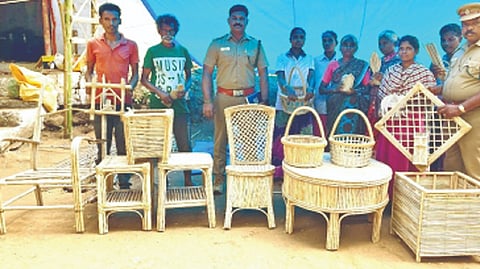

MADURAI: Lantana Camara, an invasive species endangering the forest ecosystem, has become a primary source of livelihood for forest dwellers in Anamalai Tiger Reserve (ATR).
This invasive plant has been transformed into a variety of simple and elegant furniture at the skillful hands of artisans in Lower Poonachi settlement in Valparai Range. People from the Pulaiyar community, indigenous to this part of the region spend a week, every month in the forests collecting the stems of matured lantana.
“It would be sufficient for a month’s work. The sticks are boiled and their bark is peeled off before putting them into use. One big armchair requires one bundle of stem, weighing around 30 kg. A variety of furniture including stools, chairs, tables, book shelves, sofa sets, toys and cots are crafted using the plant, which has invaded much of Kadambarai section,” said a tribal artisan.
In the last 45 days, Ashoka Trust for Research in Ecology and the Environment (ATREE), an NGO has facilitated training in furniture making to 10 families, out of the total 48 settled in the lower Poonachi settlement.
“To help the artisans manage their business independently, efforts were being made to train, motivate, encourage, innovate and expand their market. And, to ensure sustainability of this enterprise, the artisans will be made to participate in different exhibitions to popularize the concept and create awareness about its significance,” said S Ramasubramanian, Conservator of Forest and ATR Field Director.
Significantly, efforts to destroy the weed species through such alternative techniques has also started to yield desired results.
For artisans, who gathered lantana camara found in abundance on the forest fringes, are going up to 5 kilometers inside the forest to collect the resource now. Though it is not possible to destroy the species completely, its spread could be controlled by this way, claim officials.
“Once a patch of forest is cleared of lantana, then friendly species will reclaim the space. As per estimates, over 20 per cent of the ATR has been covered with lantana, thereby affecting the biodiversity of the forests seriously. Clearing one acre of land with moderate density of lantana takes 30 human days,” said MG Ganesan, Deputy Director of ATR.
Further, the officials of the ATR have also planned to market the products through official websites and social media besides establishing a direct platform at Attakatti, Aliyar check post and Top Slip.
Visit news.dtnext.in to explore our interactive epaper!
Download the DT Next app for more exciting features!
Click here for iOS
Click here for Android